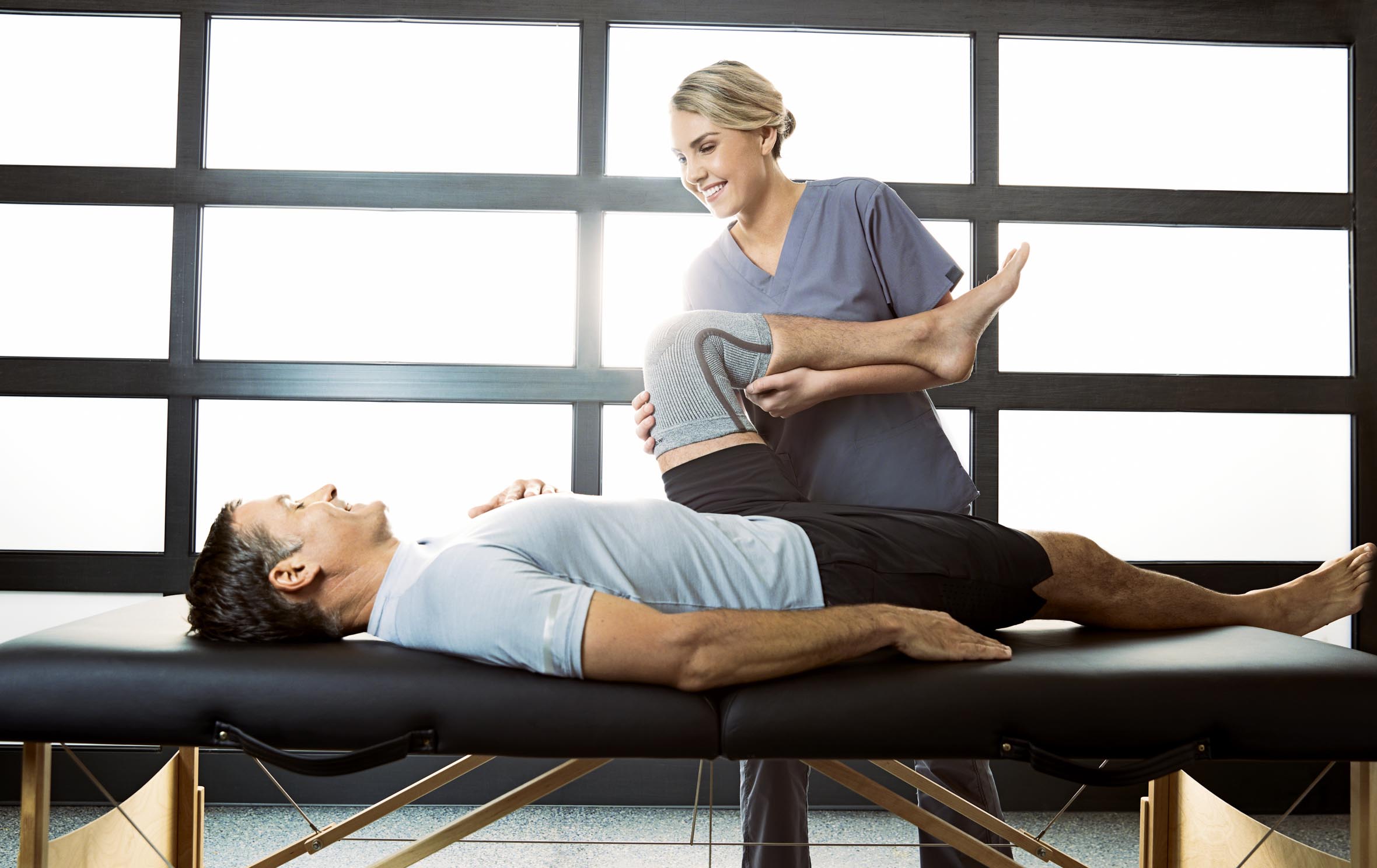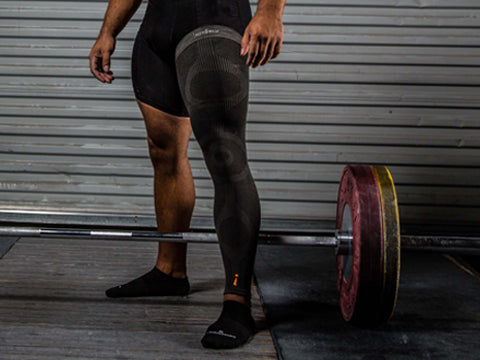Recovery gear for legs like socks and stockings are used to apply pressure to legs and ankles to reduce discomfort and improve blood circulation from your lower extremities to your heart. Besides, recovery garments including recovery calf sleeves, protect your muscles, improve your endurance, and stabilize your joints. You can push yourself a bit further without worrying about injury or over-burn. You will turn into a stronger, more agile athlete who can run the extra mile without any fear.

Recovery wear for the leg is specially designed to apply pressure to the lower legs. Your doctor can prescribe recovery socks or stockings to
- Support veins
- Boost circulation in your legs
- Diminish leg swelling
- Lower orthostatic hypotension
- Improve lymphatic drainage
- Reverse venous hypertension
- Lower the pain caused by varicose veins
- Prevent venous ulcers

Recovery wear for legs applies pressure to the legs and ankles that can increase the volume and velocity of blood flow and lower the diameter of major veins. Besides, they help move blood flow up toward the heart and prevent blood from refluxing downward to the foot or into superficial veins.
If your doctor has recommended you to use a sleeve, keep in mind that it is important for the sleeve to fit properly. Besides, you should follow the instructions when putting on or removing it. You should also follow the instructions of the doctor regarding when and how long to wear it. If you notice any skin changes while using a sleeve, you should immediately stop using it and get in touch with your doctor.

Common myths on recovery wear
Rumors, reluctance, misconceptions, and preconceived ideas on recovery wear persist. Are the myths about recovery clothes preventing you from buying and using these? Then, it’s time to debunk the truth. Let’s explore these together -
Myth 1: Only professionals can wear recovery clothing
Wrong, it is nothing but a misconception. You don't need to be a pro to wear recovery wear. Anyone can wear and get benefited from this. In fact, anyone who wants to boost his or her performance can wear recovery wear for the ankle, hand or leg. Wearing recovery clothes on some body parts can help lower vibrations, fatigue and muscle damage. Besides, these sleeves can delay muscle soreness and boost one's performance.
When you wear recovery wear after physical activity, it improves muscle recovery as it allows more oxygen to the compressed areas. Besides, it eliminates toxins faster and eliminates swelling. Your doctor's recommendation is not necessary for this. So, irrespective of whether you are a pro athlete, an occasional gym-goer or an average competitor, you can benefit from wearing recovery clothing.
Myth 2: Recovery clothes are ugly
Nope! Nowadays, stylish, casual and effective recovery clothes are available in a variety of fibers. And they come in bright colors, prints and patterns. When you buy recovery socks and stockings, they are available in different lengths - thigh-high, knee-high, and pantyhose. Besides, you can choose from opaque and sheer. The options available are so stylish and beautiful that these can easily lure you. You will simply feel the benefits as you go through the day.
Advancement in research and design also means that recovery clothes of today offer more performance features. You can choose recovery socks that have odor-reducing, antibacterial properties, and offer irritation-free flat toe seams.
Myth 3: One can wear these products at any time & situation
No, it is absolutely wrong. One's body needs different types of attention during various stages of the workout. This is why different types of recovery wear are designed. For example, during workouts, you would like to wear recovery clothing to protect from injuries, while after a workout, you may want recovery wear that will maintain snug compression on muscles that are prone to being sore.
Are you nursing a sore calf muscle but eager to get back to running? Then, you may need a recovery sleeve on your calf during running to minimize vibrations. It is vital to pay attention to the type of recovery products you purchase for your needs. The best way to do so is to research various types of recovery clothing and then pick the best fit for you.
Myth 4: It will make you feel hot
Absolutely wrong! If you have ever worn recovery wear, you can never say anything like this. As recovery clothing are made out of light and breathable material, you can wear it at any season regardless of the temperature outside. The materials of these gears are made of optimized thermoregulation and allow air to circulate through the fabric. It protects the wearer against overheating.
Besides, most recovery wear is also dry-wicking. This means it helps pull the sweat and moisture off your body. It eliminates the possibility of your skin blistering and protects against fungal infections. Also, the material is super easy to wash and dry quickly. So, you can use it again right away.
Myth 5: Science does not approve it
Another myth! Recent analysis based on 40 scientific studies on recovery show that recovery clothes improve performance and recovery when used properly, regardless of the sport.
Some studies published show that recovery clothes does not have positive effects and thus there is no requirement to wear it. Possible reasons may be that the recovery clothing is not suitable. Perhaps it was too strong or too weak. But it skews the data and reflects inconsistent results.
The bottom line is that the use of proper recovery gears that are the right fit for you and are used for the correct phase of workout - before, after or during - will have positive results.
Myth 6: These gears don't lower the risk of injury
A misconception! Although recovery garments are not designed to prevent injuries, it can be used to minimize the risk of injuries. According to studies, continuous use of recovery wear during competitions and training lowers if not eliminates the risk of injury. It holds the muscles together better by lowering the vibrations when you run or jump. These products offer you better body control. It means your body is using less energy holding itself together so that you can spend more energy on the performance of your body.
And this focus on the body's performance helps you be more aware of what you are doing. Therefore, you are more likely to injure yourself. Since recovery clothes tend to stabilize your muscles, you will have lower chances of injuring a compressed body part.
Myth 7: You can't trust these clothes
No. In the marketing world, the term "recovery wear" is not a protected term. It means although many brands tout the label of being a recovery garment, in reality, that garment is super light. Just because a garment is tight-fitting, it does not necessarily mean it is recovery wear. Actual gears are made to fit some parts of the body.
For instance, men's undergarments that are recovery clothes are shaped to fit the male body in all the right places. It is similar for arms, elbows, thighs, calves, or anywhere else where you might wear a recovery sleeve. Recovery wear for calves will fit at the top of the calf to prevent slipping. When it is snug over the curve of the calf, it can help maintain appropriate compression.
If you doubt whether you can use a product as recovery wear or not, ask others who use it regularly and then make the purchase.
Myth 8: Recovery clothes are costly
Not really! Recovery clothing is considered a medical product that meets a medical need. Besides, they also meet standards of performance. Compliance with those standards determines that materials used, the fabric finish, the level of compression, the technique used in weaving - all these contribute to the cost of the product.
The price varies from shop to shop. So, whether you are looking for a hand sleeve or the best foot ankle sleeve, the ideal thing that you can do is to ask for quotes from different shops, compare them properly and then opt for the one that asks for a reasonable price. This way you can get a good product at a fair price.

The bottom Line
While some misconceptions veer into the realm of over-exaggeration, the perks are undeniable. The glaring upside of compression gear is that it has no side-effects. Rather, it offers natural protection. In other words, wearing this equipment is an unambiguous win-win situation for an individual.
So, do you now want to have some recovery clothing for boosting your performance? Well, get it from the comfort of your home. Order it from us, at Incrediwear, and get it delivered to your doorstep.
Read more

Over the past few years, anti-inflammatory recovery wear has become increasingly popular, especially for athletes. Used in conjunction with exercise and recovery, pressure clothing strengthens soft...

Giving it you’re all in the gym or on the sports field doesn't have to be so taxing. Working out will become your new favorite hobby if you take a few steps to encourage healing and opt for recove...






Leave a comment
All comments are moderated before being published.
This site is protected by hCaptcha and the hCaptcha Privacy Policy and Terms of Service apply.